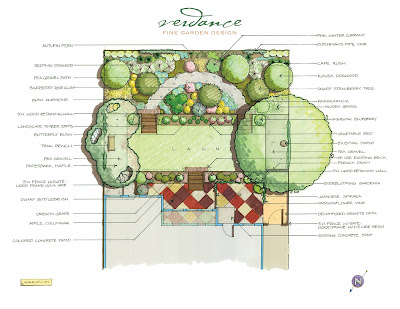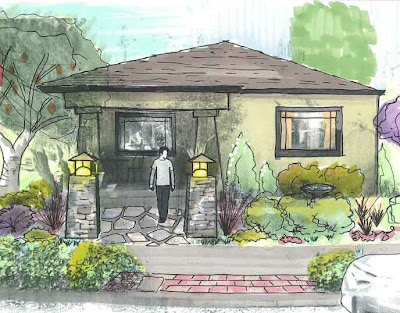 A hand-drafted design conceptTo translate my vision, I rely on clear, detailed design plans. There are any number of ways to create plans, from quick sketches to detailed hand-drafting to the precision of computer-aided design (CAD), and every designer has their favorite set of planning tools.
A hand-drafted design conceptTo translate my vision, I rely on clear, detailed design plans. There are any number of ways to create plans, from quick sketches to detailed hand-drafting to the precision of computer-aided design (CAD), and every designer has their favorite set of planning tools. For better or worse, recent years have seen a burgeoning of "do-it-yourself" garden design software; it's aimed at homeowners, but some landscape designers and contractors use these programs as well to streamline their processes. On the other end of the spectrum are high-powered CAD programs such as AutoCAD and VectorWorks, which can lay out a semiconductor chip or a 200-story office tower as handily as a flagstone patio. And somewhere in between are apps like Google SketchUp, powerful enough for pros to rely on but easy enough for almost anyone to learn and use at some level.
 SketchUp and hand-sketching over a photo
SketchUp and hand-sketching over a photoIn my studio, I find the clearest way to communicate my ideas is with a suite of SketchUp, VectorWorks and hand-drafting. I do love me some tech: VectorWorks lets me precisely plot site dimensions, features and structures, and quickly calculate areas and quantities, while SketchUp helps me reality-check my ideas, often helping me recognize their impracticality (or impossibility) before I get too wedded to them.
But there's a dark side to all this power and convenience: we can easily become dependent on it, and begin to design within its limitations. In other words, we might have a great idea — but if we don't know how to execute it with AutoCAD, that idea never makes it to the design. Or if we persist, and invest the time to learn how to execute that idea with AutoCAD, we have less time to explore other, possibly better ideas. Drafting by hand gives me the speed and flexibility to churn out a dozen very different concepts in a day if necessary; even in a program as friendly as SketchUp, such dexterity is virtually impossible.
The ASLA has recently published a piece on what technology can do for landscape architects. It's an interesting read from an insider's point of view. And, it doesn't miss the bigger picture: that there are some things technology just can't do.
No comments:
Post a Comment